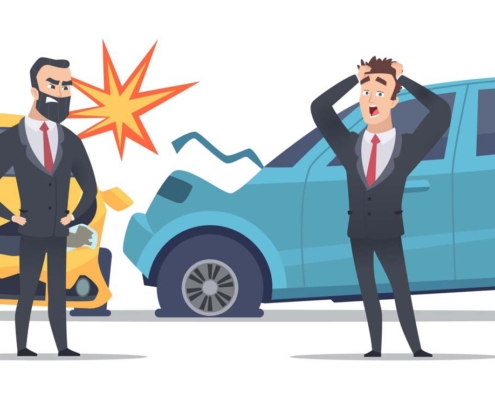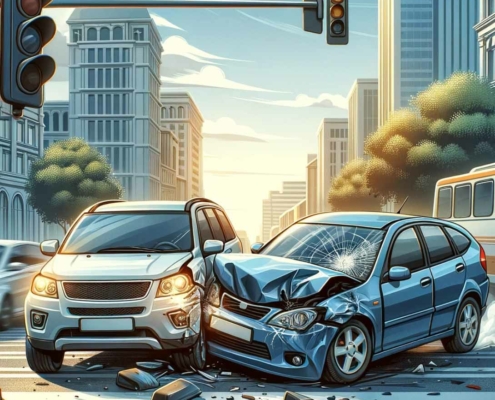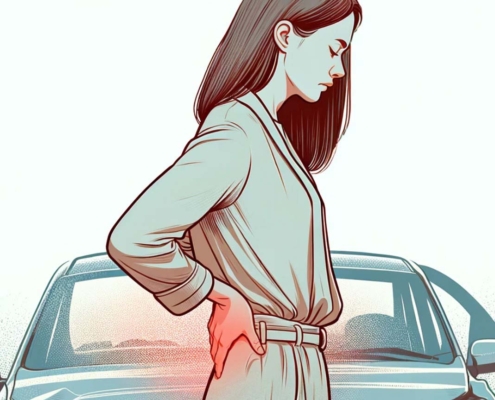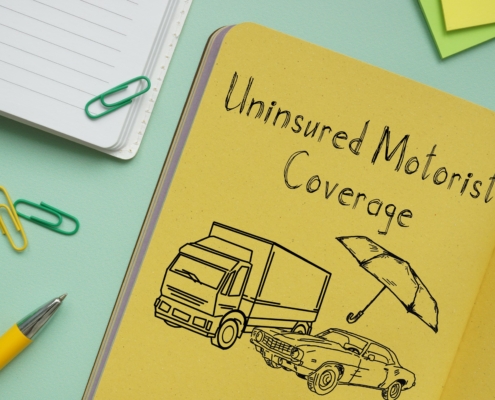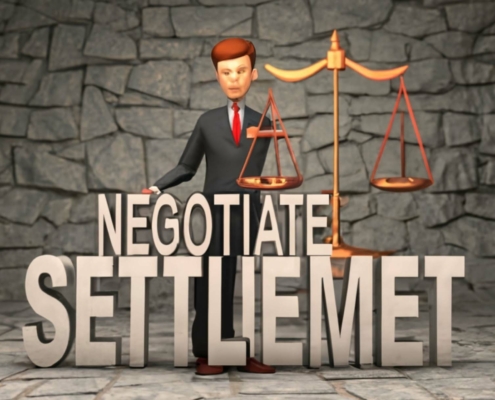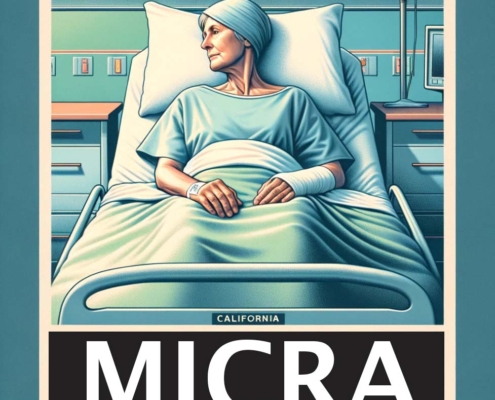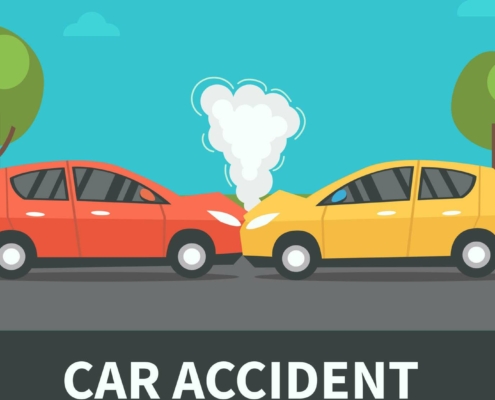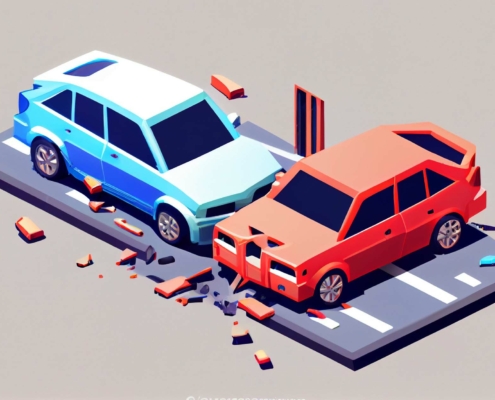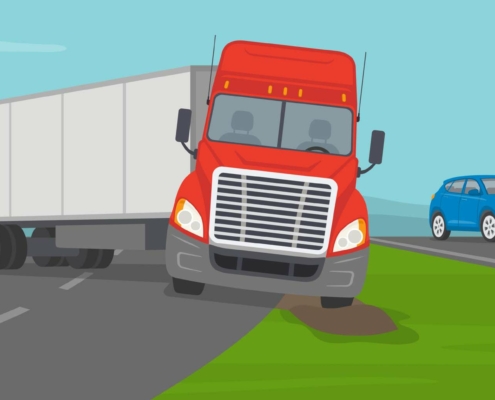Overview
Example 1 – Having Uninsured Motorist Coverage
Karen’s day took a turn for the worse when a driver without insurance ran a light and crashed into her car. The impact was severe causing Karen to suffer from injuries and rendering her car completely totaled. With bills amounting to $25,000 and the loss of her primary mode of transportation Karen felt overwhelmed by the situation. Luckily she had Uninsured Motorist (UM) coverage in place. This coverage served as a financial safety net for her covering all her expenses and providing compensation for the loss of her vehicle. Without this protection Karen would have been forced to shoulder these costs on her own potentially depleting her savings or plunging into debt. UM coverage not granted her the necessary funds to recover and replace her car but also offered peace of mind during this challenging period. It transformed what could have been a financial disaster into a manageable circumstance highlighting the undeniable importance of being prepared for unexpected events. The true value of motorist coverage became evident, to Karen when it stepped in to cover both her $25,000 medical bills and the loss of her car following an accident caused by an uninsured driver.
Example 1 – Not Having Uninsured Motorist Coverage
Adams life took a turn when his car got hit by a driver who didn’t have insurance. It was an experience and his car was completely damaged. Dealing with the aftermath was overwhelming; Adam had to pay $25,000 for treatment related to his injuries and since he didn’t have Uninsured Motorist coverage he found himself in a financial mess. His health insurance only covered a portion of the expenses leaving him with a significant gap that needed to be filled. Additionally without any coverage for his car he couldn’t get any compensation for the loss. Had to rely on his hard earned savings. The financial pressure was intense causing him stress during the day and sleepless nights. This incident taught Adam a lesson, about the importance of having Uninsured Motorist coverage as he faced the consequences of an accident that wasn’t his fault but ended up burdening him financially. He realized the impact of not having this kind of coverage when he had to handle $25,000 in medical bills and cope with losing his car without any financial assistance after being struck by an uninsured driver.
How Insured Motorist Coverage Helps
Uninsured Motorist Coverage is an important component of auto insurance, offering protection in various situations. Here are ten key truths personal injury lawyer knows about uninsured motorist coverage:
- Protection Against Uninsured Drivers: It provides financial protection if you’re in an accident with a driver who lacks insurance. This is crucial as you might otherwise bear the costs of the accident yourself.
- Underinsured Motorist Coverage Included: Often, this coverage also includes protection against underinsured drivers, covering the shortfall if the at-fault driver’s insurance is insufficient.
- Covers a Range of Expenses: It typically covers medical expenses, lost wages, and other damages resulting from an accident caused by an uninsured or underinsured driver.
- Not Mandatory Everywhere: This coverage isn’t required in all states. While highly beneficial, it’s an optional add-on in some regions, making it essential to know your state’s insurance laws.
- Policy and State Variations: Coverage details, including deductibles and limits, vary by policy and state, necessitating a thorough review of your policy’s terms.
- Hit-and-Run Accidents: Uninsured Motorist Coverage often includes protection in hit-and-run incidents, although reporting to the police promptly may be required.
- Family Member Coverage: In many policies, this coverage extends to family members living in the same household, offering broader protection.
- Can Cover Pedestrian Accidents: It’s not limited to accidents while you’re driving; it can also cover you if you’re hit as a pedestrian by an uninsured motorist.
- Stackable Coverage in Some States: Some states allow “stacking” of uninsured motorist coverage across multiple vehicles, potentially increasing the total available coverage in an accident.
- Affordability and Value: Compared to the overall cost of an auto insurance policy, uninsured motorist coverage is generally affordable and can offer significant financial protection relative to its cost.
These ten truths about uninsured motorist coverage highlight the comprehensive nature of Uninsured Motorist Coverage and its importance in providing financial security in various vehicular incidents. It’s a crucial aspect of auto insurance that can offer peace of mind in the face of increasing numbers of uninsured drivers on the roads.
Affordability and Value
The truth about uninsured motorist coverage lies in its affordability and value, offering significant financial protection for a relatively small addition to the overall insurance premium. “Affordability and Value” in the context of Uninsured Motorist (UM) coverage refers to the balance between the cost of adding this coverage to your auto insurance policy and the benefits it provides.
What It Means
- Affordability: This relates to the cost of adding UM coverage to an existing auto insurance policy. Generally, it’s considered relatively low-cost compared to other parts of an auto insurance policy.
- Value: This is about the benefits or protection the coverage provides relative to its cost, especially considering the potential financial impact of an accident with an uninsured or underinsured driver.
Cost Comparison
- The additional cost of UM coverage varies widely based on factors like location, policy limits, your driving record, and the overall level of coverage.
- On average, UM coverage can add anywhere from 5% to 20% more to your policy cost, but this is a rough estimate and can differ significantly.
- It’s important to get a personalized quote from your insurance provider for an accurate figure.
Pros and Advantages
- Cost-Effective Protection: For a relatively small increase in premium, UM coverage offers significant financial protection.
- High Benefit-to-Cost Ratio: Considering the potentially high costs of an accident with an uninsured driver, the coverage provides great value.
- Peace of Mind: The reassurance of being protected against uninsured drivers can be worth the extra cost for many drivers.
Cons and Disadvantages
- Additional Expense: It’s an extra cost on top of your regular insurance premium, which might be a concern for those on a tight budget.
- Not Always Utilized: If you live in an area with a low rate of uninsured drivers, the likelihood of needing to use this coverage decreases.
- Coverage Limits: There are limits to what UM coverage will pay, which might not cover all costs in the event of a serious accident.
- Redundancy for Some Drivers: Those with comprehensive health and disability insurance might find some aspects of UM coverage redundant.
In conclusion, the affordability and value of Uninsured Motorist coverage lie in its relatively low cost compared to the substantial financial protection it offers. The decision to add this coverage should consider individual circumstances, including the prevalence of uninsured drivers in your area and your personal risk tolerance. While it is an additional cost, the protection it provides can be invaluable in the event of an accident with an uninsured or underinsured driver. However, weighing this against your budget and existing coverage is important to make an informed decision.
Protection Against Uninsured Drivers
Protection against uninsured motorists, a feature of auto insurance policies, provides coverage when you’re involved in an accident with a driver who lacks sufficient insurance. Here’s a detailed explanation:
What It Means
- Uninsured Motorist Protection: This insurance covers expenses when the at-fault driver in an accident doesn’t have insurance.
- Underinsured Motorist Protection: It also often covers situations where the at-fault driver’s insurance is insufficient to cover all the damages or medical expenses.
Pros and Advantages
- Financial Security: It protects you from significant financial loss in an accident with an uninsured or underinsured driver.
- Covers Various Expenses: This can include medical bills, lost wages, pain and suffering, and sometimes vehicle repair costs.
- Hit-and-Run Accidents: Coverage often extends to hit-and-run incidents, providing a safety net in these situations.
- Family Member Coverage: It usually covers you and family members living in your household, even as pedestrians or in other vehicles.
- Peace of Mind: Knowing you’re covered in these scenarios can offer considerable peace of mind, especially in areas with high rates of uninsured drivers.
Cons and Disadvantages
- Additional Cost: It adds an extra cost to your insurance premium, which might be a concern if you’re on a tight budget.
- Coverage Limitations: There are limits to how much it will pay, which may not always cover all costs, especially in severe accidents.
- Legal Requirements Vary: Not all states require this coverage, leading to confusion about its necessity or benefits.
- Complexity in Claims: Filing a claim under uninsured motorist coverage can sometimes be more complex, requiring proof that the other driver was uninsured and at fault.
- Potential Overlap with Other Coverage: If you have other comprehensive health or disability insurance, there might be overlaps, making some aspects of this coverage redundant.
In summary, protection against uninsured motorists is designed to safeguard against financial losses caused by drivers without adequate insurance. The truth about uninsured motorist coverage is that it provides essential protection against the financial risks of accidents with uninsured drivers, ensuring that covered individuals are not left to bear the costs alone. While it brings additional costs and may have some limitations, its benefits, particularly in terms of financial security and peace of mind, are significant. The decision to include this coverage in an auto insurance policy should be based on individual circumstances, including the prevalence of uninsured drivers in your area and your personal financial situation.
Covers a Range of Expenses
The truth about uninsured motorist coverage is its comprehensive nature, covering a wide range of expenses from medical bills to lost wages, in accidents involving uninsured or underinsured drivers. “Covers a Range of Expenses” in the context of Uninsured Motorist (UM) coverage refers to the breadth of financial protection this coverage provides in the event of an accident with an uninsured or underinsured driver.
What It Means
- Broad Financial Protection: UM coverage typically includes a variety of costs that might arise from such an accident. These can include:
- Medical Bills: Covering medical treatment for injuries sustained in the accident.
- Lost Wages: Compensation for income lost due to injury-related work absence.
- Pain and Suffering: In some cases, UM coverage may offer compensation for pain and suffering caused by the accident.
- Vehicle Repair Costs: Although more commonly covered under collision coverage, some UM policies might help with vehicle repairs.
Cost Comparison
- The additional cost of UM coverage varies depending on several factors, such as your location, driving history, and existing coverage levels.
- On average, adding UM coverage can increase your total premium by about 5% to 20%, but this is a general range and can differ based on individual circumstances.
Pros and Advantages
- Comprehensive Protection: It provides a safety net for a variety of unexpected expenses following an accident.
- Cost-Effective: For a relatively modest increase in premium, it offers significant financial protection.
- Essential in High-Uninsured Areas: Particularly valuable in regions with high rates of uninsured drivers.
- Peace of Mind: Knowing that a wide range of potential costs are covered can offer significant peace of mind.
Cons and Disadvantages
- Additional Cost: It represents an extra expense on top of standard insurance premiums.
- Not Always Necessary: For drivers in areas with low uninsured motorist rates, or those with comprehensive health and auto insurance, it might be less critical.
- Coverage Limits: UM coverage has its limits, and in some severe cases, it might not cover all costs.
- Complex Claims Process: Claiming under UM coverage can sometimes be more complicated, requiring proof of the uninsured status of the at-fault driver.
In summary, the “Covers a Range of Expenses” aspect of Uninsured Motorist coverage means it provides broad financial protection against various costs arising from an accident with an uninsured or underinsured driver. While it adds an additional cost to your insurance premium, the comprehensive nature of the coverage it offers can be a valuable aspect of your overall insurance protection strategy, especially in areas with a high incidence of uninsured drivers. However, individual needs and circumstances should guide the decision to include this coverage in your auto insurance policy.
Not Mandatory Everywhere
“Not mandatory everywhere” in the context of Uninsured Motorist (UM) coverage refers to the fact that the requirement to have this type of insurance varies by state in the United States.
What It Means
- Varied State Laws: Each state has its own laws regarding auto insurance. In some states, UM coverage is required as part of your auto insurance policy, while in others, it’s optional.
- Optional in Some Regions: In states where UM coverage is not mandatory, drivers have the choice to add it to their policy or not, depending on their needs and risk assessment.
The truth about uninsured motorist coverage is that while it’s not mandatory everywhere, its absence can leave drivers vulnerably exposed to financial risks in states where it’s optional.
Policy and State Variations
The truth about uninsured motorist coverage is that it varies significantly in terms of policy details and state regulations, necessitating a careful evaluation to understand the specific protection it offers. “Policy and State Variations” in the context of Uninsured Motorist (UM) coverage refers to the differences in how this coverage is defined, offered, and regulated across different states and by various insurance companies. These variations can include differences in coverage limits, types of damages covered, and whether the coverage is mandatory or optional.
To illustrate these variations, let’s consider a hypothetical side-by-side comparison of UM coverage in two different states and how two insurance companies (Company A and Company B) might offer this coverage in each state.
| Factor |
State 1 – Company A |
State 1 – Company B |
State 2 – Company A |
State 2 – Company B |
| Mandatory/Optional |
Mandatory |
Mandatory |
Optional |
Optional |
| Coverage Limits |
$25,000 per person / $50,000 per accident |
$30,000 per person / $60,000 per accident |
$20,000 per person / $40,000 per accident |
$25,000 per person / $50,000 per accident |
| Types of Damages Covered |
Bodily injury and property damage |
Bodily injury only |
Bodily injury and property damage |
Bodily injury only |
| Premium Increase |
+15% of total policy cost |
+12% of total policy cost |
+10% of total policy cost |
+8% of total policy cost |
| Stacking Allowed |
Yes |
No |
No |
Yes |
| Hit-and-Run Coverage |
Included |
Not included |
Included |
Included |
This table is a simplified illustration and may not reflect actual insurance offerings. The actual terms can vary widely based on the specific state laws and individual insurance company policies. It’s important for drivers to check with their insurance provider and understand the specifics of their state’s requirements and the options available to them.
Hit-and-Run Accidents
The truth about uninsured motorist coverage is that it often proves invaluable in hit-and-run accidents, providing financial recourse when the at-fault driver cannot be identified or lacks insurance. “Hit-and-Run Accidents” in the context of auto insurance refers to incidents where a driver causes an accident and then leaves the scene without providing contact information or offering assistance. This can leave the victim with damages or injuries but no identifiable party to hold responsible. In such cases, Uninsured Motorist (UM) coverage can be particularly valuable.
To illustrate the difference in coverage for hit-and-run accidents, let’s create a side-by-side comparison table showing what is typically covered with and without Uninsured Motorist coverage.
| Coverage Aspect |
Without Uninsured Motorist Coverage |
With Uninsured Motorist Coverage |
| Identification of At-Fault Driver |
Not required (as the driver has fled) |
Not required (as the driver has fled) |
| Medical Expenses |
Not covered, unless you have separate medical or personal injury protection coverage |
Typically covered, up to the limits of your UM policy |
| Vehicle Repair Costs |
Not covered, unless you have collision coverage |
May be covered in some policies, but often under collision coverage |
| Lost Wages |
Not covered, unless under personal injury protection (where available) |
Often covered, depending on the policy terms |
| Pain and Suffering |
Not covered, unless you have additional coverage |
Often covered, up to the policy limits |
| Legal Assistance |
No coverage for pursuing legal action against an unknown driver |
Coverage may include legal assistance in pursuing claims |
| Deductible |
Collision coverage deductible applies (if you have collision coverage) |
UM coverage may have a lower or no deductible |
| Premium Impact |
No specific impact for hit-and-run (but may be affected by claiming on collision coverage) |
Claiming on UM coverage may affect future premiums, but typically less than a collision claim |
This table is a general guide and the specifics can vary depending on your insurance policy and the laws in your state. It’s important to review your insurance policy to understand the exact coverage you have and to consider the benefits of adding Uninsured Motorist coverage for added protection, especially in areas with a high incidence of hit-and-run accidents.
Family Member Coverage
The truth about uninsured motorist coverage is that it often extends beyond the policyholder, offering crucial financial protection to family members living in the same household in the event of an accident with an uninsured driver. “Family Member Coverage” in the context of Uninsured Motorist (UM) insurance refers to the inclusion of family members living in the same household in the policyholder’s UM coverage. This means that if a family member is involved in an accident with an uninsured or underinsured driver, they too are covered under the policyholder’s UM coverage.
To provide a clearer understanding, let’s create a table comparing the coverage scenarios for family members with and without Uninsured Motorist coverage:
| Coverage Aspect |
Without Uninsured Motorist Coverage |
With Uninsured Motorist Coverage |
| Coverage for Family Members in Own Vehicle |
No specific coverage; dependent on their personal auto policy |
Covered under the policyholder’s UM coverage |
| Coverage for Family Members as Passengers |
No specific coverage; depends on the vehicle owner’s policy or their health insurance |
Covered under the policyholder’s UM coverage |
| Coverage for Family Members as Pedestrians |
No specific coverage; reliant on personal health insurance or the at-fault party’s insurance |
Covered under the policyholder’s UM coverage |
| Medical Expenses |
Not covered unless through individual health insurance or another auto policy |
Covered up to the limits of the UM policy |
| Lost Wages |
Not covered unless through personal injury protection (if available) or another auto policy |
Covered, depending on the policy terms |
| Pain and Suffering |
Not covered unless under another auto insurance policy |
Typically covered, within the policy limits |
| Legal Assistance |
No coverage for legal assistance in cases involving uninsured motorists |
May include coverage for legal assistance in claims against uninsured motorists |
This table outlines general scenarios, and actual coverage details can vary based on the specific insurance policy and the state regulations. Family Member Coverage in UM policies is particularly beneficial as it extends protection beyond the policyholder to their immediate family, providing broader financial security against accidents involving uninsured or underinsured drivers. It is always advisable to review your insurance policy details or consult with your insurance provider to understand the exact scope of coverage for family members.
Can Cover Pedestrian Accidents
The truth about uninsured motorist coverage is that it’s not just for vehicle collisions; it can also provide essential coverage for pedestrian accidents involving uninsured or underinsured drivers. “Can Cover Pedestrian Accidents” in the context of Uninsured Motorist (UM) coverage refers to the aspect of this insurance that provides protection not just for vehicle collisions, but also for incidents where the policyholder or covered individuals are involved in accidents as pedestrians and the at-fault party is an uninsured or underinsured motorist.
Here’s a side-by-side comparison table to illustrate the differences in coverage for pedestrian accidents with and without Uninsured Motorist coverage:
| Coverage Aspect |
Without Uninsured Motorist Coverage |
With Uninsured Motorist Coverage |
| Injury as a Pedestrian |
No coverage unless through personal health insurance or the at-fault party’s insurance |
Covered, including medical expenses, up to the UM policy limits |
| Hit-and-Run Incidents |
Generally not covered unless under personal health insurance or collision coverage (if a vehicle you own is involved) |
Often covered, subject to policy terms and conditions |
| Medical Expenses |
Typically not covered unless through health insurance |
Covered, which can include hospital bills, treatment costs, and rehabilitation expenses |
| Lost Wages |
Not covered unless through personal injury protection or health insurance |
Often covered, providing compensation for time off work due to injuries |
| Pain and Suffering |
Not covered unless under another insurance policy |
Typically covered, offering compensation for the physical and emotional distress caused by the accident |
| Legal Assistance |
No coverage for legal costs in seeking compensation from an uninsured motorist |
May include coverage for legal assistance to recover damages |
| Deductibles and Limits |
Dependent on health or other insurance policies |
Subject to the terms of the UM coverage, often with specific deductibles and limits |
This table highlights the broadened scope of protection provided by Uninsured Motorist coverage, extending beyond typical vehicle accidents to include scenarios where the insured is a pedestrian involved in an accident. Without UM coverage, individuals often rely on their health insurance or personal injury protection (if available) for coverage, which may not fully address all accident-related expenses. UM coverage offers a more comprehensive safety net, covering a range of costs and providing added security in the event of pedestrian accidents involving uninsured or underinsured drivers. It is crucial to understand the specifics of your policy, as coverage details can vary.
Stackable Coverage in Some States
The truth about uninsured motorist coverage in some states is its stackable feature, allowing policyholders to combine coverage limits from multiple vehicles for greater financial protection in accidents. “Stackable Coverage” in the context of Uninsured Motorist (UM) coverage refers to a policy option available in some states that allows policyholders to increase their coverage limits by combining the UM coverage limits of multiple vehicles insured under the same policy or across multiple policies they own. This effectively “stacks” the coverage limits, providing a higher total amount of coverage available in the event of an accident with an uninsured or underinsured driver.
Here’s a table illustrating the difference in coverage scenarios with and without stackable Uninsured Motorist coverage:
| Coverage Aspect |
Without Stackable UM Coverage |
With Stackable UM Coverage |
| Maximum Coverage Limit |
Limited to the UM limits of the vehicle involved in the accident |
Combined UM limits of all vehicles/policies, providing a higher total limit |
| Coverage for Multiple Vehicles |
Each vehicle has its own UM limit, which applies only when that specific vehicle is involved in an accident |
UM limits of all insured vehicles can be combined, regardless of which vehicle is involved |
| Flexibility in Claims |
Coverage limit is fixed based on the policy of the vehicle involved |
More flexibility in coverage, potentially leading to higher claim payouts |
| Cost of Premiums |
Standard UM coverage cost for each vehicle |
Higher premium due to increased coverage limits |
| Beneficial in Severe Accidents |
Coverage may be insufficient in severe accidents with high costs |
Higher combined limits can better cover expenses in severe accidents |
| Policy Complexity |
Simpler policy structure with straightforward limits |
More complex policy, requiring understanding of how limits are stacked |
Stackable UM coverage provides an advantage in situations where the expenses of an accident exceed the UM limits of a single vehicle’s policy. It allows for a higher collective coverage limit, which can be particularly beneficial in accidents resulting in substantial medical costs or severe damage. However, this option usually comes with higher premiums due to the increased coverage limits. The availability and specifics of stackable coverage can vary significantly between states and insurance providers, so it’s essential to consult with your insurance agent to understand the options and implications for your policy.


